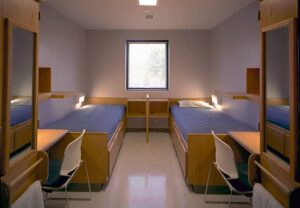
As I waited to be released from seg, I received a kite (internal institutional mail) from the director of Shakopee’s Women of Wellness program (WoW). She invited me to participate in the six week “in-patient” mental health program. I would be transferred to Monahan, Shakopee’s mental health living unit. I felt a little excitement. I would get back on track and do better!


Shakopee’s prison “cells” were atypical to me and the Monahan living unit surprised me yet again. Built later, it had a different design. Entering Monahan was like stepping into another place. Instead of cold white paint and rough concrete block, it delivered soothing lilac colors and smooth bedroom walls! It sported large, airy classrooms, soft carpet, and bigger windows. While I still felt uneasy and shut-down, I did feel relief as I stepped into this new environment.



The prison installed me in ‘Lower B,’ one of the 8 pods inside Monahan. Gigi, my previous coworker, also lived there. Gigi was generous but reserved. Ten years older than me, she had long brown hair and eyes. “Do you need anything?” she asked. Soon she provided me with coffee and other treats. I felt wanted. I gratefully accepted.
Next door to me was Sylvia, a 65 year old woman who had been here in Lower B for several years. Sylvia walked with a cane and occasionally needed a wheelchair. She was a retired English professor and was extremely reserved, rarely speaking or leaving her room, yet I liked her right away.
Sylvia’s roommate, Kim, also spent most of her time in their cell. She stared out the window all day. Someone told me Kim hallucinated her children out playing in the yard, and it appeared to be true, as I watched Kim wave and talk to people not there. When Kim noticed me staring, she blushed and dropped her hand. I got the impression she’d been told there was no one outside the window but couldn’t stop the illusion or her response. Kim had been here so long she remembered when cigarettes were sold on canteen. While she was also highly reserved she was unassuming and kind as well. She would die a few years later from Huntington’s disease.
Each day for the next 6 weeks I went to classes for better sleep, less anxiety, and emotional balance. I also learned to crochet, a hobby I’d enjoy for years.
WoW provided tools for behavior modification. I did need that – yes I did, but was unaware that total life transformation is possible. WoW doesn’t provide a new life, it helps one have a better day.
I finished the WoW mental health program in November and became eligible for the workforce. I checked my mail daily, waiting for a new job assignment. I was also using my skills as an artist to make an extra buck drawing portraits from photos for other inmates.
C.S. Lewis states accurately in Mere Christianity, “No man knows how bad he is till he has tried very hard to be good.” He states further, “Unless we really try, whatever we say there will always be at the back of our minds the idea that if we try harder next time we shall succeed in being completely good….All this trying leads up to the vital moment at which you turn to God and say, ‘You must do this. I can’t.’” I was the “try harder next time” person.
I turned my attention to a return to work. Most inmates receive only half their paycheck. The rest is taken in enforced savings, fines, fees, and the like. For many (and often me!) that meant working for 12.5 cents per hour, fulltime, and receiving a two week total paycheck of $3.50 on average.
Alarmingly, if I was unable manage thousands of dollars a month when free, how was I going to manage living on a fraction of that now? It seemed impossible. Finally I was rewarded with an assignment – and industry it was – General Assembly, known to us inmates as Rubber.
The prison moved me back to Tubman and I began working the week before Thanksgiving.
4 Not her real name
Matthew 11:28-29
“Come to Me, all you who labor and are heavy-laden and overburdened, and I will cause you to rest. I will ease and relieve and refresh your souls.
29 Take My yoke upon you and learn of Me, for I am gentle, meek and humble in heart, and you will find rest (relief and ease and refreshment and recreation and blessed quiet) for your souls.” ~Jesus
Discussion Questions:
- Holly describes her transfer to the mental health living unit at MCF-Shakopee, which is known for its comfortable and non-traditional prison environment. How does the portrayal of the prison’s physical space challenge or reinforce your preconceived ideas about prisons?
- The passage provides historical information about MCF-Shakopee’s development and contrasts it with older prison facilities. In what ways do you think the physical environment of a prison can impact the rehabilitation and mental health of inmates?
- The passage draws parallels between the COVID-19 lockdowns and the restrictions within Shakopee, particularly the no-touching rule. In what ways do you see similarities between the experiences of incarcerated individuals and those who faced lockdowns during the pandemic? How does social isolation impact mental health, and what measures can be taken to mitigate its effects? Are you struggling with isolation and loneliness today? Do you need help?
- Holly highlights the impact of loneliness and isolation on mental health, citing studies that link severe loneliness to health risks comparable to smoking, obesity, and physical inactivity. How has the COVID-19 pandemic increased awareness of the mental health challenges associated with isolation? What strategies can be implemented to address loneliness and isolation in different contexts?
- The passage describes Holly’s experience of inadvertently breaking the no-touching rule and the resulting emotional impact. How do strict rules and regulations within a prison environment affect the behavior and emotional well-being of inmates? Can you empathize with the challenges of adapting to a highly regulated social environment?
- Holly discusses the consequences of social isolation, including emotional detachment, social awkwardness, and anxiety. How might these consequences affect an individual’s chances of successful reintegration into society after incarceration? Do you face any of these challenges right now? Are you searching for help?
- Holly reflects on her initial perception of WoW as a provider of tools for behavior modification rather than a catalyst for total life transformation. What are your thoughts on the role of rehabilitation programs in prisons? Do you believe such programs should focus on behavior modification, complete life transformation, or a combination of both? Are you seeking personal transformation today?
- Holly hints at a future transformation in her life. What factors or events do you think will contribute to this transformation, and what kind of impact do you foresee it having on her overall narrative? Do you want help today at moving forward with future transformation and hope for your own life?
READ MORE…
- Chapter 1: JAILIntake process at the county jail passed in a blur. Well that’s not exactly true. It dragged on, so boring it became forgettable. An officer transported me by police car from the local police station to the county jail. Hands… Read more: Chapter 1: JAIL
- Introduction: Get to know From Surviving to Living!Click to rate this post! [Total: 0 Average: 0]
- Chapter 2: BAIL, SENTENCING, & PRISON INTAKEReleased on bail after 3 months in jail, Chad arrived to bring me home, telling me in the car, “We’re being evicted and everything has to be out of the house by the end of the day.” At home nothing was packed… Read more: Chapter 2: BAIL, SENTENCING, & PRISON INTAKE
- Chapter 3: GROWING UPClick to rate this post! [Total: 0 Average: 0]
- Chapter 4: ORIENTATION (CHANGE, SHOCK & AWE, SUICIDE WATCH)Part One March 2011 – September 2015 “There is none righteous [none that meets God’s standard], not even one.” ~Romans 3:11 (AMP) “The way of the wicked is like [deep] darkness; they do not know over what they stumble.” ~Proverbs 4:19 (AMP)… Read more: Chapter 4: ORIENTATION (CHANGE, SHOCK & AWE, SUICIDE WATCH)
- Chapter 5: MARRIAGEJust before my 19th birthday, I married Scott, a man I had dated in high school. On a whim we drove to Las Vegas with some friends and got married. My parents were upset by my impulsive decision. They asked… Read more: Chapter 5: MARRIAGE
- Chapter 6: A PADDED ROOM (THE PICKLE SUIT)Suicide watch in Shakopee takes place in the facility’s segregation unit. While inmates are taken to seg for disciplinary reasons, it is also used for suicide watch and health concerns. Soon I would be seeing it for myself. Seven months… Read more: Chapter 6: A PADDED ROOM (THE PICKLE SUIT)
- Chapter 7: WoWAs I waited to be released from seg, I received a kite (internal institutional mail) from the director of Shakopee’s Women of Wellness program (WoW). She invited me to participate in the six week “in-patient” mental health program. I would be transferred… Read more: Chapter 7: WoW
- Chapter 8: RING TOSS & DOPPELGANGERSMy job in General Assembly (Rubber) was housed in a large warehouse building shared by several educational and industry job opportunities. There were 2 main jobs – ring inspections and cutting rubber. I was assigned to rings. Base pay was… Read more: Chapter 8: RING TOSS & DOPPELGANGERS



















